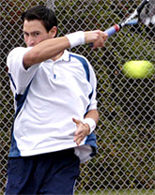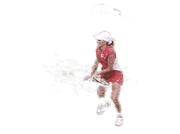The Physics of Power:
How Angular Momentum Shapes the Forehand
By Chris Lewit

When you swing a knife or a sword, you may not be thinking about physics—but physics is definitely at play. The difference in how fast they move, how much force they deliver, and how they feel in your hand all comes down to principles like angular momentum and angular velocity. Interestingly, these same concepts help explain the evolution of the modern tennis forehand, particularly in how players wield lightweight, stiff racquets to produce explosive power. Let's dive into the science of rotational motion and then explore how it connects directly to your game on the court.
Angular Velocity, Radius, and Tip Speed
When you swing any object around a fixed point—your shoulder, elbow, or wrist, for example—you generate angular velocity. This is how fast the object is rotating. The linear speed at the tip (how fast the end moves through space) depends on how far that tip is from the axis of rotation. For an incredible visual of this in action, check out this month's music video. (Click Here)
Linear Velocity at Tip = Angular Velocity (ω) × Radius (r)
This means that a longer sword or racquet (greater r) will have a faster-moving tip at the same angular velocity. That's why longer weapons or tools can generate more cutting or striking force—if you can accelerate them.
Momentum, Mass, and Force
Next, consider momentum—the product of mass and velocity:
Momentum = Mass × Velocity
A knife is easier to swing quickly, but it doesn't have much mass, and its shorter length limits its tip velocity. A sword is heavier and longer, which means it may be harder to accelerate, but once it's moving, it hits much harder.
The angular momentum of a swinging object is:
Angular Momentum (L) = Moment of Inertia (I) × Angular Velocity (ω)
Since longer and heavier objects have higher moments of inertia, they store more angular momentum and deliver more powerful impacts—but they are also harder to swing quickly.
Weapon Comparison Chart
| Aspect | Knife | Sword |
|---|---|---|
| Easier to accelerate | Yes | No |
| Reaches target fast | Yes | Maybe (depends on swing) |
| Tip speed | Lower (shorter radius) | Higher (longer radius) |
| Force on impact | Lower (less mass & momentum) | Higher (more mass & momentum) |
| Angular momentum | Lower | Higher |
Tennis Racket as a Weapon: The Sword of the Court
Swinging a tennis racket is remarkably similar to wielding a sword or knife. The human arm and shoulder act as pivot points, and the racket behaves like a lever, delivering energy to the ball via angular velocity and tip speed.
In the past, players used heavier wooden racquets, which had more mass but were difficult to swing quickly. These racquets demanded more compact arm lengths at impact and larger backswings and didn't lend themselves easily to high angular speeds or extended lever lengths, or easily creating lag.
Modern racquets, however, are lighter and stiffer, and this has revolutionized the way players swing.
The Rise of the Straight Arm Forehand
Because today's racquets are lighter, players can swing them faster (higher angular velocity) while also extending the lever—using a straighter arm. This increases the radius (r) from the shoulder or torso pivot point to the racquet tip. With both greater angular velocity and greater radius, players generate incredible tip speeds—translating into more powerful and spin-heavy shots. Importantly, players don't need to take giant looping backswings to overcome inertia and to build high angular velocity.
Moreover, these lightweight racquets make it easier to use the the lag phenomenon. The wrist can stay relaxed and "lag" behind the rest of the swing, only to accelerate through at the last second, adding whip-like acceleration to the stroke. This kind of sequencing is much harder with heavy wooden racquets due to their inertia.
From the Battlefield to the Baseline
The physics that governed ancient warriors wielding swords now influence elite tennis players like Carlos Alcaraz or Emma Navarro. Both use compact backswings, a relaxed arm and wrist, racquet lag, a long lever, exceptional angular velocity to generate explosive shots. Their strokes are a direct result of the physics of rotational movement—refined by years of technical evolution and better equipment.
Final Thoughts
Understanding angular momentum and its role in sports can give players and coaches a powerful perspective. Whether you're holding a sword or a Babolat Pure Aero, the same laws of motion govern your success.
If you're coaching or playing, think about:
- Relaxed distal joints (elbow, forearm, wrist)
- Compact backswings
- Lever length (longer = more tip speed)
- Racquet mass (lighter = easier to accelerate)
- Timing and sequencing (lag and whip = power and spin)
Train your body like a weapon—and wield your racquet like a sword.




